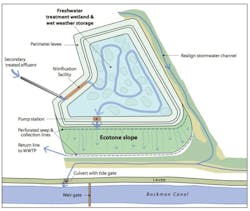Experimental levee in California to filter wastewater, protect shoreline
Construction is just about to start on an experimental levee and wetland basin adjacent to the Oro Loma wastewater treatment and purification plant in San Lorenzo, California.
The $6.8 million project will test how shoreline wastewater treatment plants can improve water quality while also providing habitat restoration in a time of drought and protecting communities from flooding caused by climate change.
Oro Loma and Castro Valley Sanitary Districts have teamed up with UC Berkeley, Save the Bay and others to create an "outdoor laboratory" that will test ways in which the Oro Loma plant can mimic nature to filter wastewater and protect the shoreline. If it works, they hope the project can serve as a model for adapting other critical infrastructure at the edge of San Francisco Bay to climate change.
The new levee ("ecotone slope") is designed to mimic the natural slope from historic wetlands into upland areas. Planted with sedges and grasses, and irrigated with treated wastewater, this newly created habitat could slow down waves, resist floods and protect infrastructure and homes in the Bay Area flats.
The development will allow wastewater that has passed through the treatment facility to be further filtered through plants and soil microbes, removing some of the nutrients — and possibly the trace amounts of pharmaceuticals and synthetic hormones — that remain in the water after conventional treatment.
First, the water will go through a treatment wetland full of native cattails and bulrushes, removing an estimated 10-30 percent of nutrients. Next, it will seep into a layer of gravel and wood chips. At this stage, microbes living in the wood chips will absorb nitrates and release inert nitrogen gas through a process known as denitrification. Meanwhile, plants growing in the soil above will take up some of the water and nutrients through their roots.
Scientists will test the water going in, passing through and coming out of the system to measure how effective the ecotone is at removing nutrients and other impurities.

